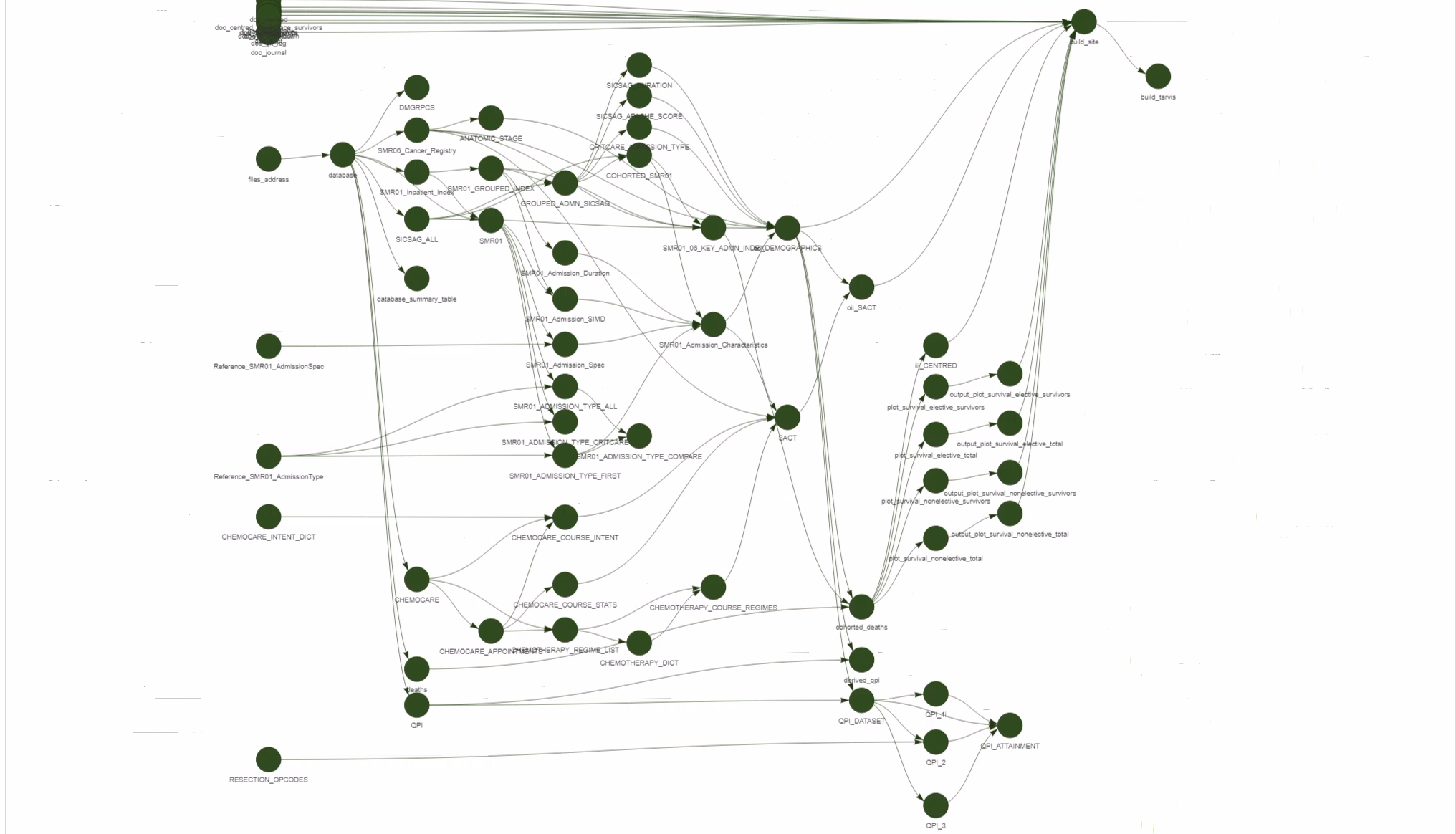Project Overview
Callum Taylor
2023-05-01
What happens to people with cancer, during and after their stay in critical care?
What happens to people with cancer, during and after their stay in critical care?
How likely is it that they get their cancer treatment?
How likely is it that they survive?
What could their survival look like?
(What might their death look like?)
Impact of Critical Illness on Subsequent Cancer Care and Outcomes, in Patients With Colorectal Cancer
Why Colorectal Cancer?
Scotland has the highest rate of this in the UK
It affects 1 in 20 patients in their lifetime
(It’s the dataset I have access to)
Critical Illness Is Common In Colorectal Cancer
~1/6 of Patients with Colorectal Cancer have critical care stay in first two years 1
~Half of these patients will require a form of organ support during their stay 1
1: Puxty 2015 JAMA OncologyProposed Study
How does critical illness affect:
Likelihood of cancer specific treatment (QPIs)
Quality and quantity of cancer specific treatment (SACT)
Disease/symptom/functional outcomes
CORECT-R Dataset
Thesis Chapter Outline
- 00a. Intro
- 00b. Methods
- 00c. Demographics of Cohorts
- Quality Performance Indicators
- Systemic Anti-Cancer Therapy
- Patient Centred Outcomes
- Conclusions
Population - 43,145
2006/01–2018/12
Surgical Admissions
Planned Crit Care
Curative Intent
Demographics - Still To Do
- Received an Operation
- Type of Surgery
- Comorbidities
Quality PerformanceIndicators
| QPI | QPI | QPI |
|---|---|---|
| Diagnosis/Staging | Pre-Op Imaging | Stoma Care |
| MDT | Lymph Node | Radiotherapy |
| Surgical Margins | Re-Operation | Dehiscence |
| Post Op Mortality | Adjuvant Chemo | Post SACT Mortality |
| Clinical Trials | Liver Mets |
You are less likely to get your post op adjuvant chemotherapy, if you have a critical illness requiring organ support.
Elective QPIs1
Emergency QPIs1
QPI 111

Still To Do
- Updated Cohorts
- Updated Confounders Info (Comorbidities, etc)
Systemic Anti-Cancer Therapy
| Outcome | Descriptive | Modelling |
|---|---|---|
| Time To Start Systemic Anti-Cancer Therapy | ||
| Duration of Systemic Anti-Cancer Course | ||
| Form of SACT (Regimen) | ||
| Intent of SACT (Curative Vs Palliative) |
Patient Centred
| Outcome | ||
|---|---|---|
| Survival1 | ||
| Burden of Healthcare / DAAH | ||
| Sx: Pain/Mental Health/Nutrition | ||
| Change in Accomodation | ||
| Place of Death1 |
Mandatory Degree Steps
- Initial Review ✔
- Annual Review ❓
- 3000 Word Report
- Presentation To Supervisor Panel
- Credits: 4 (Induction, 3x Applied Stats)
- Presentations: ✔
- Publications: ✗
Problems
- Toxicity/Symptoms
- Performance Status:
- WoS, Grampian, Tayside, Highland
- Frailty
- No package of care
- No functional assessment
- Incomplete Performance Status
Other Aspects - ?Future Work
- Emergency Department Attendances
- GP Out of Hours Use
- Scottish Ambulance Service Use
- NHS 24 Use

Demographicss
| Elective Hosp | Emergency Hosp | |||||
|---|---|---|---|---|---|---|
| No CritCare | CritCare - No Organ Support | Organ Support | No CritCare | CritCare - No Organ Support | Organ Support | |
| N | 10,023 | 14,523 | 2,643 | 11,061 | 3,541 | 1,354 |
| Planned Crit Care | 0 | 12,024 | 1,354 | 0 | 782 | 106 |
| Surgical Admn | 8,581 | 14,481 | 2,632 | 6,284 | 3,389 | 1,283 |
| Curative Intent | 6,104 | 11,965 | 2,124 | 2,600 | 2,061 | 777 |